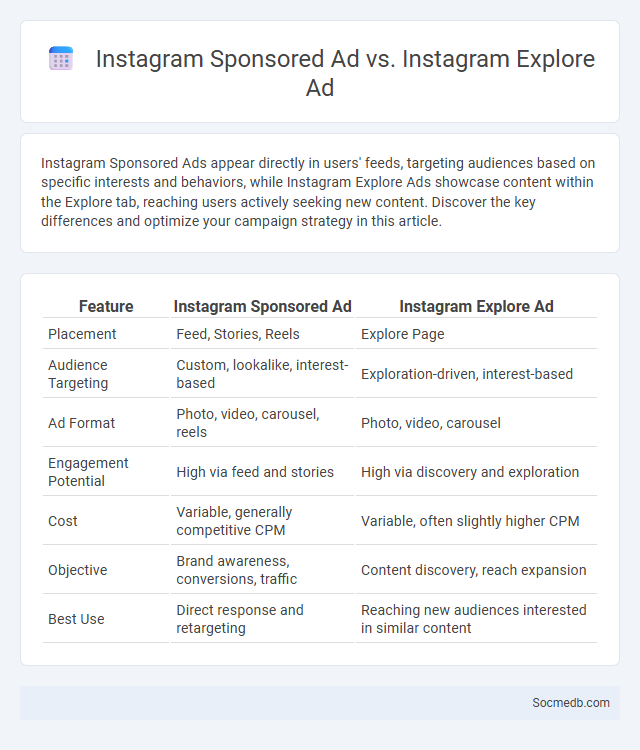
Photo illustration: Instagram Sponsored Ad vs Instagram Explore Ad
Instagram Sponsored Ads appear directly in users' feeds, targeting audiences based on specific interests and behaviors, while Instagram Explore Ads showcase content within the Explore tab, reaching users actively seeking new content. Discover the key differences and optimize your campaign strategy in this article.
Table of Comparison
| Feature | Instagram Sponsored Ad | Instagram Explore Ad |
|---|---|---|
| Placement | Feed, Stories, Reels | Explore Page |
| Audience Targeting | Custom, lookalike, interest-based | Exploration-driven, interest-based |
| Ad Format | Photo, video, carousel, reels | Photo, video, carousel |
| Engagement Potential | High via feed and stories | High via discovery and exploration |
| Cost | Variable, generally competitive CPM | Variable, often slightly higher CPM |
| Objective | Brand awareness, conversions, traffic | Content discovery, reach expansion |
| Best Use | Direct response and retargeting | Reaching new audiences interested in similar content |
Introduction: Understanding Instagram’s Ad Formats
Instagram's ad formats include photo ads, video ads, carousel ads, and Stories ads, each designed to engage users through visually compelling content. These formats support diverse marketing goals such as brand awareness, product promotion, and customer engagement by leveraging Instagram's highly active user base of over 2 billion monthly active accounts. Optimizing ads for Instagram's interface ensures maximum reach and interaction, utilizing features like clickable links, hashtags, and targeted audience segments.
What Is a Sponsored Ad on Instagram?
A sponsored ad on Instagram is a paid promotional post designed to reach targeted audiences beyond a user's followers by appearing in feeds, Stories, or Explore sections. Businesses use Instagram's advertising platform to create visually engaging content with specific objectives such as brand awareness, website traffic, or conversions. These ads leverage Instagram's advanced targeting options, including demographics, interests, and behaviors, to maximize campaign effectiveness and ROI.
The Mechanics of Instagram Explore Ads
Instagram Explore Ads leverage advanced algorithms to analyze user behavior, interests, and engagement patterns, ensuring your content reaches highly relevant audiences beyond your followers. By integrating visual appeal with targeted placements within the Explore feed, these ads maximize discovery potential and drive higher interaction rates. Mastering the mechanics of Instagram Explore Ads allows you to enhance brand visibility and convert casual browsers into loyal customers.
Key Differences: Sponsored Ads vs. Explore Ads
Sponsored ads on social media are paid promotions designed to appear directly in users' feeds, targeting specific audiences based on demographics, interests, and behaviors, maximizing brand visibility and engagement. Explore ads, by contrast, appear within the Explore section, reaching users who are actively seeking new content, thereby driving discovery and organic interest beyond immediate followers. The key difference lies in intent and placement: sponsored ads impose visibility within familiar environments, while explore ads leverage user curiosity for broader exposure and content exploration.
Audience Targeting Capabilities
Social media platforms offer advanced audience targeting capabilities by utilizing user demographics, interests, behaviors, and location data to deliver highly personalized ads. Tools like Facebook's Custom Audiences and LinkedIn's Matched Audiences enable marketers to retarget existing customers and reach lookalike audiences with precision. Enhanced targeting options improve ad relevance, increase engagement rates, and optimize overall campaign ROI for businesses of all sizes.
Creative Formats and Placement Options
Creative formats on social media, such as carousel ads, video stories, and interactive polls, enhance user engagement by offering visually dynamic and immersive experiences. Placement options extend across feeds, stories, reels, and sponsored messages, enabling targeted audience reach based on platform behavior and preferences. Optimizing creative formats and strategic placements increases conversion rates and maximizes return on ad spend (ROAS) in campaigns across platforms like Facebook, Instagram, and TikTok.
Performance Metrics: Engagement and Reach
Performance metrics such as engagement and reach are critical indicators of social media success, measuring user interaction and content visibility respectively. Engagement rate, including likes, comments, shares, and clicks, reflects the effectiveness of content in capturing audience interest and fostering community interaction. Reach quantifies the total number of unique users exposed to a post, providing insights into the potential audience size and the overall impact of social media campaigns.
Cost Comparison: Sponsored vs. Explore Ads
Sponsored ads typically demand a higher budget due to precise targeting and increased visibility on social media platforms, leading to better click-through rates and conversions. Explore ads, often integrated into discovery sections like Instagram Explore, offer a more cost-effective option but usually generate lower engagement as they reach broader, less targeted audiences. Choosing between sponsored and explore ads depends on specific campaign goals, budget constraints, and desired return on investment (ROI).
Use Cases: When to Choose Each Ad Type
Social media ad types vary in effectiveness depending on your campaign goals, such as brand awareness, engagement, lead generation, or conversions. Choose video ads for storytelling and high engagement, carousel ads to showcase multiple products, and sponsored posts for direct interaction with your target audience. Understanding the strengths of each format helps you optimize your ad spend and maximize return on investment.
Conclusion: Which Instagram Ad Format Is Best For You?
Choosing the best Instagram ad format depends on your campaign goals, target audience, and content style. Carousel ads are ideal for showcasing multiple products or features, while Stories ads engage users with immersive, full-screen visuals. Your decision should align with how you want to connect with your audience and the type of interaction you aim to generate.
 socmedb.com
socmedb.com